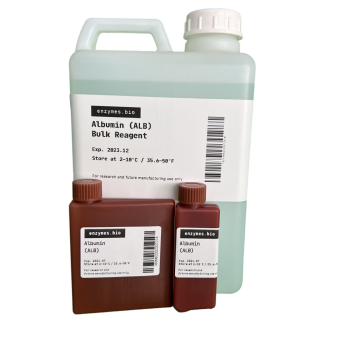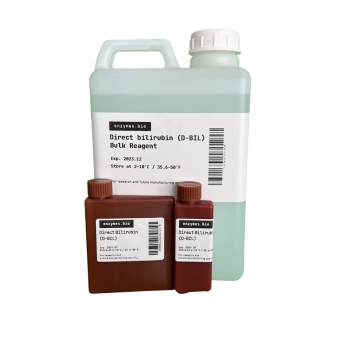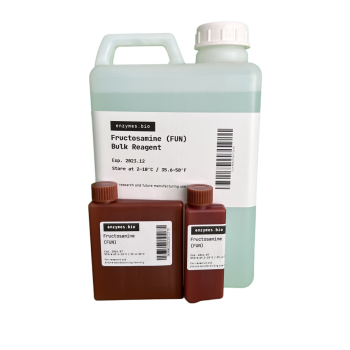Selling unit: per 100ml
Product Name
Common name: Lipoprotein a (LPa) assay kit (latex-enhanced immunoturbidimetric assay)
English name: LPa Reagent Kit (Immunoturbidimetric Method)
Reagent Ratio
3:1, 4:1, 5:1, common ratio 4:1, other ratios need to be customized
Intended Use
This kit is used to determine the amount of LPa in human serum.
Higher than normal blood Lp(a) levels are closely associated with atherosclerosis, angina pectoris, myocardial infarction, and cerebral hemorrhage. Lp(a) is not affected by age, gender, or food, and is not correlated with other lipid changes and is not affected by most lipid-regulating drugs. In recent years, a large number of studies have concluded that serum Lp(a) levels are closely correlated with cardiovascular and cerebrovascular diseases, atherosclerosis and other diseases. In the 1988 International Lp(a) Conference, Lp(a) was identified as an independent risk factor for coronary heart disease.
Test Principle
The combination of the antigen LPa and the specific antibody (sheep anti-human LPa antiserum) sensitizing particles forms an insoluble immune complex, resulting in a turbid reaction solution, the turbidity of which reflects the amount of LPa in the serum sample. The amount of LPa in the serum can be found by comparing it with the standard solution of the same treatment.
Main Components
Reagent components included in the product.
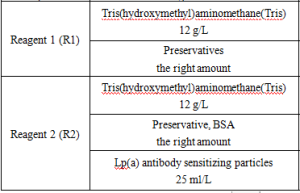
*Components are not interchangeable in kits with different lot numbers.
*Reagent components not included in the product, but necessary for the test: outsourced normal and abnormal QCs and calibrators.
Storage Conditions And Expiration Date
The kit is stored at 2-8°C away from light and is valid for one year.
Reagents that have been opened are careful not to be contaminated, and reagents are stable in the instrument compartment (2-8°C) for one month.
The reagents must not be frozen.
Applicable Instruments
Hitachi 7180/7600; Olympus AU680/2700; Toshiba TBA120; Myriad BS2000M/480; Siemens ADVIA 1800/2400 series automatic biochemical analyzers.
Sample Request
Serum. 2 to 8°C stable for 3 days.
Test Method
- Reagent preparation: liquid reagents are ready to use out of the bottle.
- test conditions: (different test instruments can be requested according to the different parameters on the machine)

Operation steps.
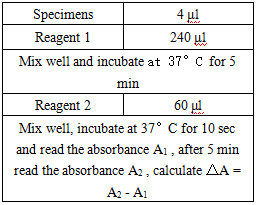
Reagents and sample volumes can be increased or decreased in proportion to the requirements of different biochemical analyzers.
- Calibration procedure.
The use of matching calibrators is recommended.
- QC control procedures.
It is recommended that each laboratory establish its own quality control system and select appropriate quality control products for quality control. The measured values of QC products should be within the specified range. If outside the specified range, it is necessary to take appropriate measures or contact the manufacturer.
- Calculation.
6-point calibration, input the corresponding value. With △A as the vertical coordinate and concentration as the horizontal coordinate, plot the standard curve, and correct this standard curve by non-linear method Spline, Logit-Log5P and other modes, and save this standard curve for calculating the results. The reagents of different batches must be re-calibrated.
Positive Judgment Value Or Reference Interval
0~300 mg/L
It is recommended that each laboratory establish its own reference range of normal values.
Interpretation Of Test Results
The determination of LPa in serum or plasma is only one of the indicators used by the clinician to make a diagnosis of the patient. The clinician must also make a comprehensive judgment based on the patient’s physical symptoms, medical history, and other diagnostic items and diagnostic tools.
Limitations Of The Test Method
Bilirubin ≤ 40 mg/dL, hemoglobin ≤ 500 mg/dL and celiac ≤ 500 mg/dL did not interfere with the determination.
Product Performance Index
Absorbance of reagent blank: wavelength 604 nm, optical diameter 1.0 cm, temperature 37°C, A0 ≤ 1.2.
Analytical sensitivity: The kit tests 240mg/L of the analyte, the absorbance change value ΔA ≥ 0.05.
Linearity range: test serum samples, reagent linearity in the interval of 40-800 mg/L, the linear correlation coefficient |r| should not be less than 0.975; in the interval of 40-300 mg/L, the absolute deviation of linearity should not exceed 30 mg/L; in the interval of (300-800 mg/L, the relative deviation of linearity should not exceed ±10%.
Precision: repeatability CV ≤ 8%; relative extreme difference between batches ≤ 10%.
Accuracy: Relative deviation ≤ 10%.
Caution
- This product is for in vitro diagnosis only.
- Avoid contamination when using the reagent, the container used must be clean, and please take necessary precautions, do not swallow, and avoid contact with skin and mucous membrane.
- Please dispose of the measured samples and waste liquids in accordance with the relevant national and local laws and regulations.
- Do not mix R1 and R2 into a single reagent.
- When changing the reagent lot number, please recalibrate.
- The latex reagent (R2) itself has a certain turbidity, and its particle diameter is 100 nm-200 nm, the particles have strong Brownian motion in the solution, so the reagent does not need to be shaken well before use.
Reference
- Lv Jinkai et al; Shanghai Journal of Medical Laboratory 4(2): 97.(1989)
- Galivin, J. P. et al; Clin Lab. Assays 4:73-95.(1983)


